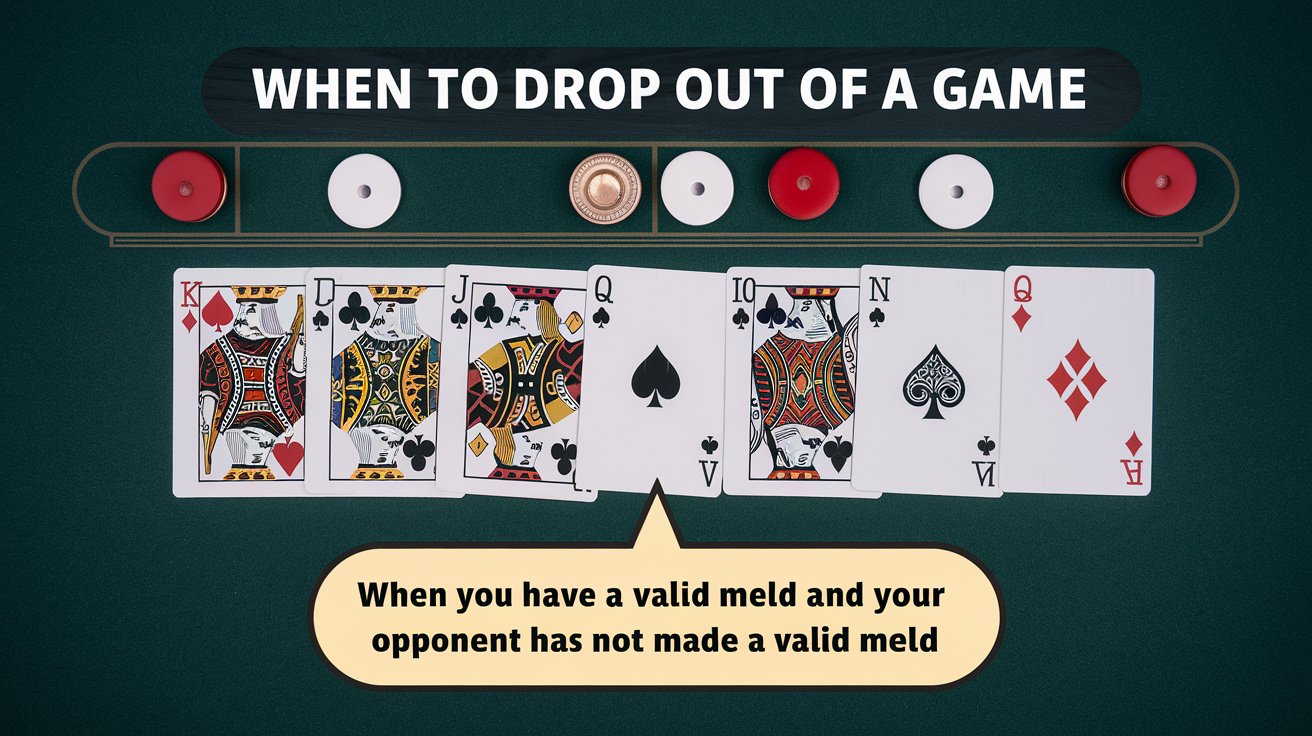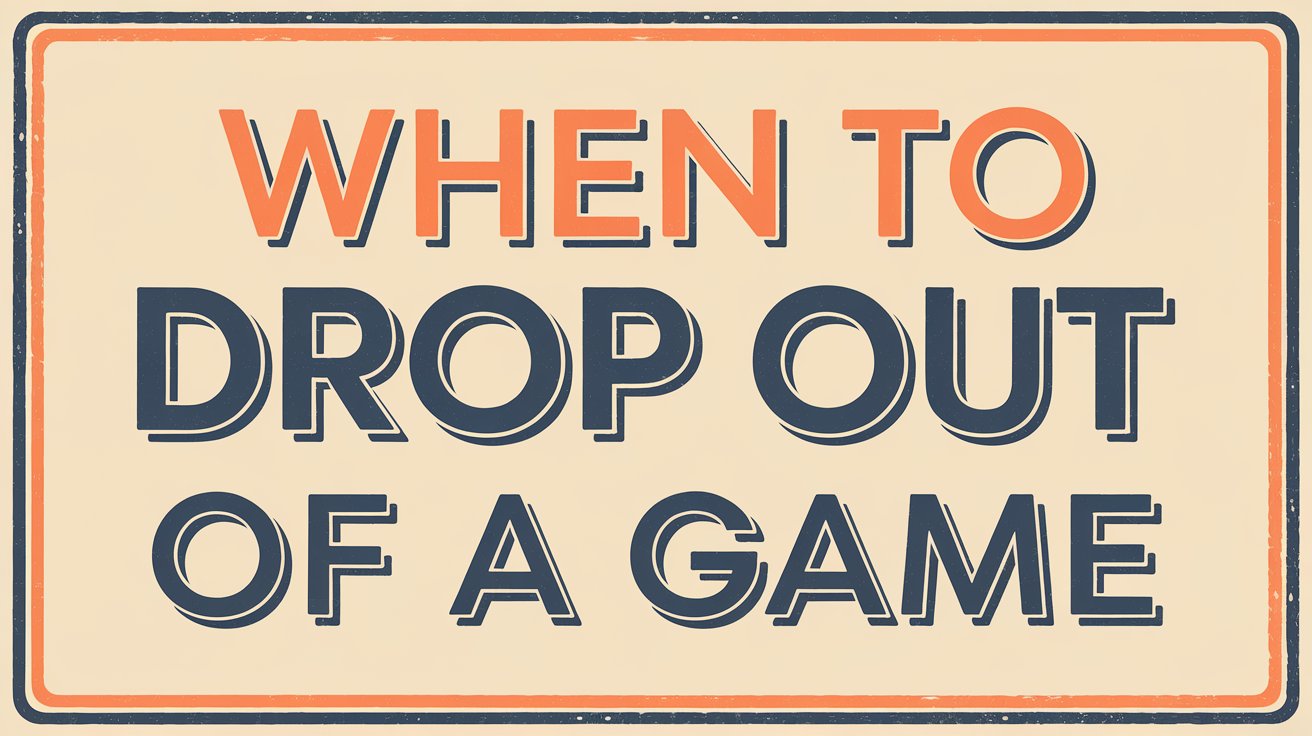Rummy is a fast-paced card game that requires skill, strategy, and sometimes, a bit of luck. While forming sets and runs is the main objective of the game, one of the most important strategic decisions a player can make in Rummy is knowing when to drop out of a game. Dropping out isn’t a sign of weakness—it’s a strategic move that, if done at the right time, can save you from losing more points and increase your chances of success in the long run.
Whether you’re playing Gin Rummy, Indian Rummy, or any other variation, understanding when to drop out of a game is crucial for minimizing your risk and making the best decisions. In this blog, we’ll explore Rummy strategy from a unique perspective: knowing when to drop out of a game and why this decision is often more valuable than continuing to play when your chances of winning are slim.
What Does It Mean to Drop Out in Rummy?

In Rummy, dropping out refers to leaving the game before the round is over. Essentially, you choose not to continue playing with your current hand. Depending on the specific variant of Rummy, the rules for dropping out may vary slightly, but the general principle is the same: you forfeit your current hand to avoid accumulating points based on the cards you have left.
Different Ways to Drop Out:
- Early Drop: In some forms of Rummy, you can choose to drop out early in the game, often before anyone has formed a set or run. This is sometimes referred to as a “First Drop” or “Initial Drop.”
- Middle Drop: A middle drop occurs when a player decides to leave the game after some cards have been drawn, usually when they realize that their chances of completing a good hand are slim.
- Late Drop: In some versions of Rummy, players are allowed to drop out even later in the game, but the penalties may increase based on how far the game has progressed.
Understanding when to drop out requires careful judgment, as continuing with a poor hand could cost you points, while dropping out might allow you to minimize the damage. The key is to recognize when the odds are against you and to make a calculated decision based on the game’s state.
Why You Should Drop Out of a Rummy Game

Knowing when to drop out is an essential part of Rummy strategy. It’s not just about quitting; it’s about minimizing your risk and maximizing your chances of winning in future rounds. Here are some key reasons why you might want to drop out of a Rummy game:
1. Your Hand Is Unplayable
The most common reason to drop out of a game is when your hand is unplayable. You may find yourself with a high-point hand that doesn’t seem to have any potential to form sets or runs. Holding onto an unplayable hand means that you’re likely going to end up with a high score at the end of the round, which is detrimental in Rummy.
Signs of an Unplayable Hand:
- You have disconnected cards that don’t fit into any runs or sets.
- You’re holding too many high-point cards (such as Kings, Queens, and Aces) that won’t help you form a combination.
- You’re one card away from completing a set or run, but no suitable cards are coming your way.
If you’ve been dealt a bad hand and don’t see any hope of completing it, drop out early to save yourself from accumulating unnecessary points.
Tip: In games where an early drop is allowed, don’t hesitate to take the opportunity if your hand is full of cards that are unlikely to form a valid combination.
2. Your Opponents Are Ahead
In Rummy, your goal is to form sets and runs faster than your opponents. However, there will be times when your opponents have formed melds and you’re far behind. If they are clearly ahead and are likely to finish their hand soon, it may be a good idea to drop out to avoid accumulating penalty points.
Why Drop Out When Your Opponents Are Ahead?
- If your opponents are close to going out, you may be unable to complete your hand in time, and continuing could cost you more points.
- If your hand is incomplete and your opponents have already completed their melds, you will likely be stuck with leftover cards, and your score will increase dramatically.
Recognizing when your opponents are ahead and dropping out at the right time can save you from the penalties of being caught with incomplete melds or high-point cards.
Tip: Observe your opponents’ moves carefully. If they have a low point total, or if they are quickly closing in on the end of the game, dropping out early could help you minimize your losses.
3. You’re Holding High-Point Cards
In Rummy, high-value cards (such as face cards like Jacks, Queens, Kings, and Aces) can quickly add up and hurt your score if you don’t complete your hand. If you are holding onto high-point cards and have no clear way to use them, it’s a good time to consider dropping out.
Why It’s Risky to Hold High-Point Cards:
- High-point cards left in your hand at the end of the game contribute heavily to your score.
- If your opponents complete their hands and go out, you’ll be left with these cards, increasing your points.
- Some variants of Rummy impose a penalty for unmelded high-point cards.
If you find that your hand is filled with high-value cards and you can’t form a set or run, dropping out might be the best choice to minimize the impact on your score.
Tip: If your hand is loaded with Jacks, Queens, Kings, or Aces, consider dropping out early to avoid losing a significant number of points.
4. You’re Stuck with Too Many Unmatched Cards
Rummy is about forming sets and runs as quickly as possible. If you’re stuck with too many unmatched cards, you may want to consider dropping out to avoid accumulating more points.
Signs You’re Stuck with Unmatched Cards:
- You have several single cards that can’t form part of a set or run.
- You’ve been waiting for a specific card, but it’s not coming up.
- You’re holding onto cards that don’t fit with the rest of your hand and can’t be used strategically.
Tip: Don’t hang onto a hand with too many mismatched cards. It’s often better to exit early and try again in the next round.
5. Evaluating the Risk of Continuing

In any card game, the risk-reward ratio is crucial. In Rummy, sometimes the risk of continuing with a weak hand can outweigh the potential reward. It’s important to assess whether staying in the game is worth it or if it’s better to minimize your losses and drop out.
How to Evaluate the Risk of Continuing:
- Look at your remaining cards: Do they have a high chance of forming a set or run? If not, you’re risking points by holding onto them.
- Monitor the number of cards left: If there are only a few cards left in the deck and you still haven’t formed any sets or runs, the risk of staying is high.
- Observe your opponents: If you suspect that one of your opponents is about to go out, continuing with a weak hand is risky.
Tip: When the risk of losing becomes high and the chances of improving your hand are slim, drop out early to avoid accumulating points.
How to Drop Out Strategically
Dropping out in Rummy isn’t just about quitting; it’s a strategic move. To make the most of this decision, consider the following:
1. Know When to Drop Early
In some versions of Rummy, you can drop out early for minimal points. If your hand is clearly unplayable or if you’re up against a strong opponent, consider taking the opportunity to drop early.
2. Minimize Your Losses
If the game has been ongoing for a while and you realize your hand isn’t coming together, drop out before your score increases. Waiting too long could result in higher points, so it’s better to act sooner rather than later.
3. Don’t Let Ego Get in the Way
It’s easy to get caught up in the desire to finish the game and avoid feeling like you’re quitting, but strategic dropping is often the best move. Don’t let your ego get in the way of making the best decision for the game.
Conclusion: Knowing When to Drop Out in Rummy
In Rummy, the key to long-term success is not only knowing when to play aggressively but also knowing when to drop out. Dropping out isn’t about quitting; it’s about making the right decision to minimize your losses and maximize your chances of success in future rounds. Recognizing when your hand isn’t working, when your opponents are ahead, or when you’re holding high-point cards that could cost you the game is critical.
By practicing patience, carefully evaluating your hand, and observing the game’s progress, you’ll become more adept at knowing when to drop out. Remember, sometimes stepping back is the best way to secure a victory in the long run.

Zareb Saleh is a journalist at Gulf Today and a ghostwriter for Gameoholic, specializing in gaming, technology, and digital culture. With a keen eye for industry trends, he delivers insightful stories that engage and inform readers.




